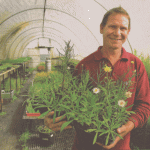
Warren Saunders and his nursery staff are Canberra’s secret gardeners, responsible for creating much of the city’s landscape that’s taken for granted.
They’ve propagated 350,000 seedlings to create 6ha of native plants along Anzac Parade, and literally got down and dirty in Mitchell’s urban wetlands, planting 150,000 native shrubs, grasses, and wildflowers. For a single revegetation project in the Brindabellas, they collected 900kg of native seed — and that’s just for the understorey plantings.
Leafing through his company’s job records recently, Mr Saunders crunched the numbers and discovered Plants and Seeds Australia, his native plant production nursery in Pialligo, has supplied more than 10 million native plants and over lot of native seed for revegetation projects. These range from mine site rehabilitation works in remote areas to Canberra’s roadside verges and embankments, and local Landcare projects. “We’ve probably done a lot more, but I stopped counting at [10 million],” he says.
Mr Saunders, a Gungarri from the western Darling Downs in Queensland, was among the first intake of indigenous cadets at Duntroon Royal Military College in 1984. He completed a science degree, but decided the army wasn’t for him. “I grew up in a big Aboriginal family, so interest in the bush, in native plants, was always there. I love botanising, going bushwalking to find plants and seeds.”
Mr Saunders grows bush tucker foods, and teaches didgeridoo at the Australian National University. He makes didgeridoos from material collected from the bush (“You look for gum trees and termites,”) and Irish band Hothouse Flowers and British singer Sting both have instruments he’s crafted.
He jokes that we need to “get away from the old-school Pommy view of green lawns and exotics” when designing urban landscapes, and experiment with native plants. “Councils plant exotic grasses on road sides and in urban parks, then spend a small fortune on mowing to keep the fire risk down … All the mowing does is spread more weeds, and keep pushing the costs up. But native grasses don’t grow as high, so fire risk and mowing bills go down, and biodiversity goes up.”
Mr Saunders estimates his nursery grows 800 native plant species, many local to the Canberra region. He’s developed a planting system that allows a person to plant 10,000 plants in a day using a two-stroke drill with a planting auger attached. “It’s unbelievably hardcore hard yakka, especially if you’re wading in muck and sewage planting a wetland — or even worse, a mine tailings dam. But if you like hardcore environmental work, this has to be one the best jobs in the world.”
By Rosslyn Beeby
Science and Environmental Reporter
The Canberra Times, Wednesday, April 27 2011
Note: copyright of the material in this clipping resides with Fairfax Media. Usage permitted in accordance with the Australian Copyright Act 1968, Section 42: Fair dealing for purpose of reporting news. Source: The Canberra Times – 27 April 2011


You should see what he’s (Warren Saunders )doing now. We would like to see updates of story’s like this please